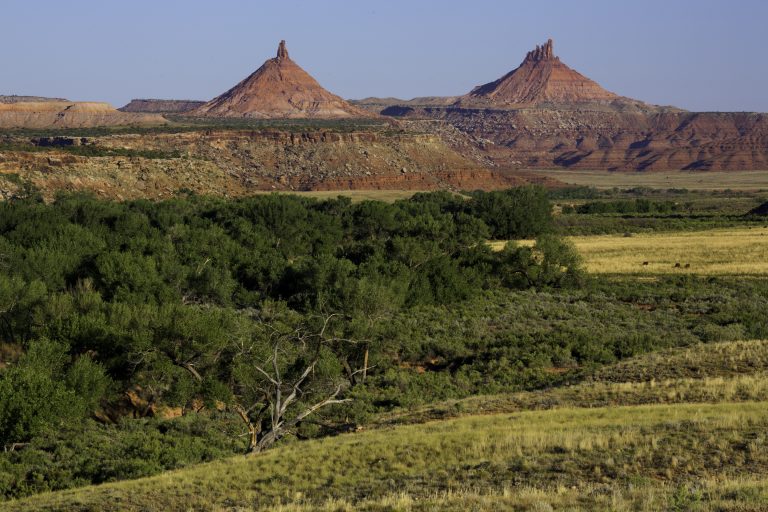Let’s not get too smug…………
by Ryan McMaken
When discussing various atrocities committed against the Native Americans throughout history, apologists for this particular type of state-sponsored killing will often resort to pointing out that Indians murdered many settlers and their families. This claim, which is true enough, really only begs the question, however, of why white Americans were on Indian lands to begin with.
The easy answer is that the settlers were poor and wanted free land. That’s true too, but to appreciate the economic and political realities behind the mass western migration of whites, we have to look at how it was encouraged and subsidized by U.S. Government policy during the nineteenth and early twentieth century.
From the very beginning, governments have had an interest in encouraging their subjects to move to new lands and colonize them. A sizable population of settlers from the mother country makes conquest easier, while providing greater ease in making claims to lands against the incursion of foreign governments.
The downside of having subjects in new lands is that it’s expensive to defend them from the indigenous population. This means having to spend money on forts and military detachments designed to protect one’s subjects from the natives.
Students of the American Revolution know that this was an important factor in the war. As the Crown saw things, the British state had incurred an enormous expense protecting American colonists from the French and various Indian tribes, and the Crown wanted the Americans to pay for it. Thus, they taxed the Americans. In addition, the Crown limited westward expansion for the colonists in an effort to keep down the expense of dealing with the Indians in the interior. The Americans resented both the taxes and limitations on new settlements.
The American victory in that war that resulted ended the British restrictions on westward expansion. By the mid-nineteenth century, a new pattern had been well established. White people moved west, and then they demanded military protection for their settlements. Members of Congress, eager to retain their seats, were happy to oblige. The move to universal manhood suffrage in the following decades then opened the door for massive voter pressure to be applied in Congress as settlers demanded more cheap land. The solution? Get rid of the Indians. The result was the Removal of Indian tribes in 1830 and similar subsequent policies. It was interest-group politics at its most pure.
By the time the Civil War ended, the U.S. government found itself with a massive standing army, and a huge frontier to open up to the voters.

With the adoption of the Homestead Act of 1862, the frontier then became America’s biggest voter-subsidy program in which the Federal government subsidized the wealth of hundreds of thousands of Americans.
Modified for various times and places, the Homestead Acts provided a legislatively designated amount of land for little or no money in exchange for living on and “improving” the land.
Prior to this, westward settlement had been more haphazard, more decentralized, and it came with fewer assurances from the Federal government that it would remove all native populations to make room for the new settlers.
Following the war, however, westward expansion entered a new phase marked by massive Federal subsidies in the form of free land, military protection, and the railroads.
There were restrictions on where settlers could move, with Indian reservations being off limits. Yet most Americans assumed, correctly, that if they moved in or near Indian territories, the U.S. government would eventually be pressured into moving the Indians into even more remote locations.
At its core, westward expansion had always been a wealth transfer scheme. It was a transfer of wealth from Indians, who did not have a vote, to whites, who did have a vote. In the post Civil War period, the Federal spending on railroads and the frontier army also transferred wealth from the taxpayers as a whole to the frontier populations. The whites in the East paid for it via tariffs and other Federal taxes while the Indians paid what might be glibly described as a 100 percent land forfeiture tax.
Following the typical sequence of events behind interest group politics, politicians who sought to respect treaties with Indians were punished at the ballot box, while politicians who were eager to oblige the voters by handing over Indian lands, were rewarded. Indeed, one might say the destruction of the Plains Indians was one of the greatest textbook examples of American democracy in action.
This was basically “stimulus” and “job creation” frontier-style, complete with shovel-ready infrastructure projects (the railroads) and plenty of military spending.
This massive stimulus project even produced its own booms, busts, and bubbles. When the Lakota were finally starved and murdered into submission, the opening of the Dakota Territory produced the Great Dakota Boom that lead to a 734% increase in population from 1870 to 1880 in what is now South Dakota. Not surprisingly, the boom ended with capital flight and a return to reality for the standard of living in the territory.
But that didn’t stop the flood west well beyond 1890, with miners, farmers, and other settlers looking for cheap land gained by military conquest and paid for with the blood of Apaches, Utes, Cheyennes and others.
Moreover, as is often the case with government wealth transfers and subsidies, the frontier stimulus and welfare programs produced a sense of entitlement in the minds of many Americans.
This attitude was even dramatized in Laura Ingalls Wilder’s autobiographical Little House series of books.
In Little House on the Prairie (1935), Charles Ingalls moves the family to “Indian Territory” in what is now Kansas. It’s not entirely clear if the land they’re settling on is open to settlement or not, but it is just assumed that it eventually will be open to settlement, so the Ingallses built a house and a farm. After several uneventful encounters with Indians, it’s the U.S. Army that forces the Ingallses off the land, informing them that the territory is not open.
This message isn’t received well by Charles, and in By the Shores of Silver Lake (1939), Charles remarks that the U.S. Government still owed him a homestead after forcing him off the Kansas land. Later, while planning his homestead in South Dakota, Charles sings a song, which was no doubt popular among homesteaders of the age:
Oh, come to this country,
And have no fear of harm,
Our Uncle Sam is rich enough,
To give us all a farm!
While not quite something for nothing, free frontier lands were nonetheless something more for something less than what would have been the case on a frontier characterized by unsubsidized markets. The settlers wanted land without having to buy it from Indians or anyone else, and they wanted to be able to move to unsettled lands without having to make provision for their own self defense. Many of us would no doubt desire the same were we in a similar situation, but the fact remains that frontier policy of the post-war period was just as much about the politics of hand-outs as anything else.
In nineteenth-century America, had freedom been the rule instead of state-managed and centrally-planned settlement, settlers would have been free to attempt a move to Indian lands of course, but without any guarantees of safety or cheap land handed over by the state. In order to be allowed to stay on Indians lands, new settlers would have had to provide services and goods the Indians could not produce themselves. Gunsmiths, blacksmiths, merchants and doctors would have all of course been highly valuable. Settlers who wanted land, on the other hand, such as miners and farmers, would have been driven off.
As always, trade would have been a great unifying and pacifying factor, and those who contend that Indians and whites were too culturally incompatible to trade are indulging in the leftist myths about Indians being unable to comprehend private ownership, trade, and markets.
Had the Feds not moved in to arrange free lands for settlers, the evolution of the frontier would have been slower, more socially complex, and would likely have been characterized by a network of whites in towns and villages along waterways and private railroads, surrounded by Indian-controlled hinterlands. There are examples of just this sort of settlement pattern in various times and places, but such processes of free settlement are of little use to states.
Much better for states is the nineteenth-century frontier model in which the central government moves in, seizes vast tracts of land, and then doles out some of it to voters. Even better for the central government is the fact that if often gets to keep huge amounts of stolen land for itself, and to this day over 50 percent of land in most Western states is owned by the Federal government.
The claim that settlers somehow had to be there and were but meek child-like innocents seeking to make their way in the world has little basis in reality. As Kit Carson noted, the reservation system became a necessity (in his mind) due to the fact that settlers relentlessly moved onto Indian lands and then agitated for more government protection, railroads, and free lands. The U.S. government was happy to oblige, and the symbiotic relationship between voter and government in the pursuit of stolen goods continues to this day.
Ryan McMaken [send him mail] is the author of Commie Cowboys: The Bourgeoisie and the Nation-State in the Western Genre.

